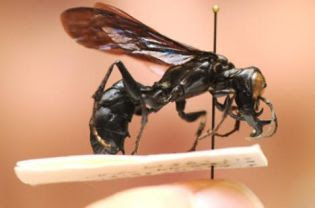Related
articles
- Project Tackles Jakarta's Mountains of Waste
- Fuel Additive Risks Health And Environment: NGO
- DPR Targeting Greenpeace in Indonesia Spat
- Indonesian Haze Spreads as Forest Fires Continue to Burn
- Illegal Turtle Trade Flourishing in Indonesia: Activists
An American
scientist working with a team of Indonesians scientists has discovered a new
giant black warrior wasp species. The wasp will be added to the list of items
named after the country’s national symbol, the mythical bird Garuda.
The
insect-eating predator was discovered by Lynn S. Kimsey, a professor of
entomology and the director of the Bohart Museum of Entomology at the University
of California, Davis, while working with 12 scientists from the Indonesian
Institute of Sciences (LIPI) during an expedition to the Mekongga Mountains of
Sulawesi.
Scientists
are shocked by the discovery of the insect, with the male wasp measuring
approximately two-and-a-half inches long. Its large jaw may play a defensive
and reproductive role similar to other wasps.
“Its jaws
are so large that they wrap up either side of the head when closed. When the
jaws are open they are actually longer than the male’s front legs. I don’t know
how it can walk,” Kimsey said in a news release. “The females are smaller but
still larger than other members of their subfamily, Larrinae.”
The
three-week expedition was funded by a five-year $4 million grant from the
International Cooperative Biodiversity Group Program to specifically study the
fungi, bacteria, plants, insects and vertebrates of Sulawesi. The team of
scientists working from the funding have discovered a bat, two frogs, two
lizards, two fish, a land crab and many insects since 2008.
American
researchers have been collaborating with three Indonesian partners: the LIPI,
the Ministry of Forestry and the Bandung Institute of Techonology. LIPI is the
lead organization in Indonesia and UC Davis is the head organization in the
United States.
The grant
also aims to study and find plants and microbes that may carry medicinal value
and energy potential as well as develop and encourage conservation strategies.
Over the
course of her career, Kimsey has discovered close to 300 new species. She
decided to name her latest discovery after the Indonesian national symbol.
“The first
time I saw the wasp I knew it was something really unusual,” Kimsey said. “I’m
very familiar with members of the wasp family Crabronidae that it belongs to
but had never seen anything like this species of Dalara. We don’t know anything
about the biology of these wasps. They are only known from southwestern Sulawesi.”
Much of
Sulawesi’s biosphere is considered threatened by logging and mining operations.
Kimsey said there are now plans for an open pit nickel mine on the mountain.
“There’s
talk of forming a biosphere reserve to preserve this,” she said. “There are so
many rare and endangered species on Sulawesi that the world may never see.”
The group
of scientists dealt with challenging conditions and survived on provisions of
ramen and rice during the expedition.
“Eventually
we had to leave because we ran out of food,” Kimsey said. “This part of
Sulawesi gets about 400 inches of rain a year. We were told that Sulawesi has a
dry and rainy season. But the only difference we could see between the dry and
rainy season is that during the dry season, it rains only in the afternoon.”
Despite the
challenging conditions, the scientist’s research has paid off.
“I consider
Sulawesi one of the world’s top three islands for biodiversity — that along
with Australia and Madagascar,” Kimsey said.



No comments:
Post a Comment